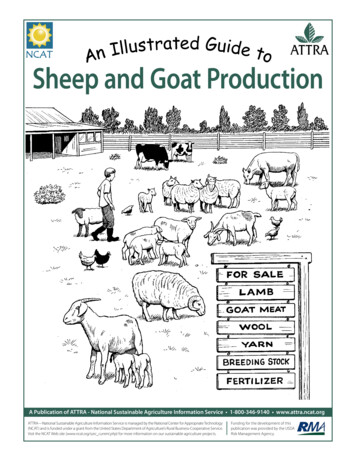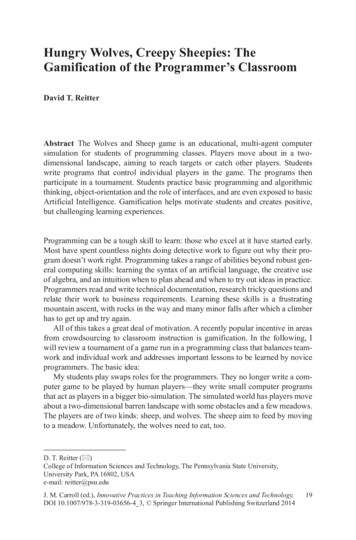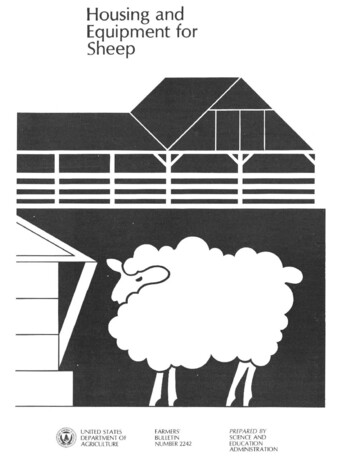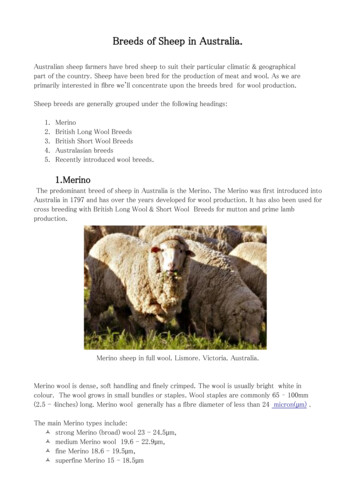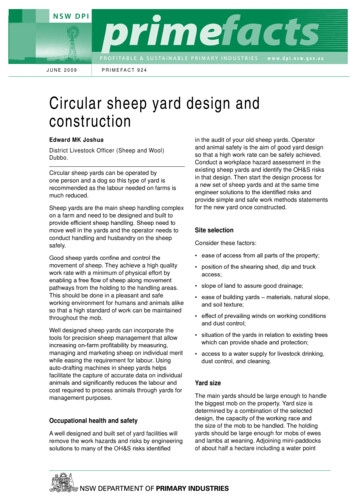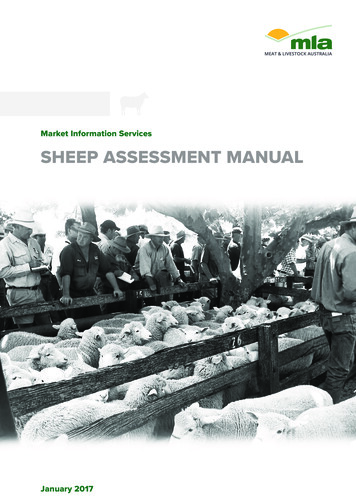
Transcription
Market Information ServicesSHEEP ASSESSMENT MANUALJanuary 2017
Meat & Livestock Australia Market Information ServicesContentsSECTION 1 – ASSESSMENT LANGUAGE .11.1 Stock Categories . 11.2 Carcase weight and live weight . 21.3 Fat Score . 21.4 Skin value . 41.5 Sales prefixes . 51.6 Age. 51.7 Frame size . 51.8 Shear season . 61.9 Joining . 6SECTION 2 – ASSESSMENTS . 7SECTION 3 – MARKET REPORT COMMENTS . 83.1 General commentary guidelines . 8SECTION 4 – QUALITY MANAGEMENT . 11APPENDIX 1 – AUS-MEAT LANGUAGE .12APPENDIX 2 – MLA’s assessment sheet .16APPENDIX 3 – UNIT OF COMPETENCY .17List of FiguresFigure 1: Reference point used for assessing fat cover on sheep and lambs . 3Figure 2: Location of the GR site . 3Figure 3: The five fat scores . 3Figure 4: MLA’s Market Information weekly skin report . 4Figure 5: Frame size . 6Figure 6: Fat class.12Figure 7: Dressing percentage matrix .15Figure 8: Sheep assessment sheet .16List of TablesTable 1:MLA stock classifications . 1Table 2:Stock categories applicable to MLA sheep store market reports . 1Table 3:Fat score table . 2Table 4:Sales prefixes. 5Table 5:MLA competency level .7Table 6:List of abbreviations; grammatical corrections and other relatedstructural suggestions .10Table 7:Basic categories . 13Table 8:Definition of a permanent incisor . 13Table 9:Alternative categories . 14Table 10: Elements and performance criteria .18Table 11:Required skills and knowledge .18Table 12: Evidence guide.19Market InformationMeat & Livestock AustraliaPh: 02 9463 9372Fax: 02 9463 9220Email: Published by Meat & Livestock Australia LimitedABN 39 081 678 364January 2017 Meat & Livestock Australia Limited 2017ISSN 1837-4690MLA makes no representation as to the accuracy of any information or advice contained in this document and excludes all liability, whether in contract, tort(including negligence or breach of statutory duty) or otherwise as a result of reliance by any person on such information or advice. Reproduction in whole or part ofthis publication is prohibited without prior consent and acknowledgement of Meat & Livestock Australia.All use of MLA publications, reports and information is subject to MLA’s Market Report and Information Terms of Use. Please read ourterms of use carefully and ensure you are familiar with its content – click here for MLA’s terms of use.Page i – SHEEP ASSESSMENT MANUAL
Meat & Livestock Australia Market Information ServicesSECTION 1ASSESSMENT LANGUAGESheep and lambs are sold in drafted consignments or pen lots. When assessing lambs MLAconsiders several factors including age, breed, sex, carcase weight, fat score and finally overallquality and condition.1.1 Stock CategoriesTable 1 depicts the factors used to determine age and sex of sheep and lambs, known as stock categories. Moreinformation can be found in Appendix 1.Table 1: MLA stock classificationsStock categoryDescriptionYoung lambMale and female lambs with no ‘ram like’ characteristics. Generally, unshorn with no permanentteeth, normally up to 5 months of ageLambMale and female lambs with no ‘ram like’ characteristics. Generally weaned, shorn with nopermanent teeth and normally older than 5 monthsHoggetCastrated male or female sheep with no ‘ram like’ characteristics and up to two permanent teethEweFemale with more than two permanent teethWetherCastrated male sheep with no ‘ram like’ characteristics and with more than two permanent teeth.RamRam and castrated male sheep with ‘ram like’ characteristics.Ram LambsUncastrated male lamb or entire male lambSource: AUSmeatTable 2: Stock categories applicable to MLA sheep store market reportsStock categoryDescriptionCrossbred lambsMale and female lambs with no ‘ram like’ characteristics. Generally weaned, shorn withno permanent teeth and normally older than 5 months. No Merino characteristicsCrossbred ewesFemale with more than two permanent teeth. No Merino characteristicsCrossbred ewes and lambsFemale with more than two permanent teeth with a lamb at foot. No MerinocharacteristicsCrossbred wethersCastrated male sheep with no ‘ram like’ characteristics and with more than twopermanent teethMerino ewesMerino ewes, female, with more than two permanent teethMerino lambsMerino lambs, male or female, with no ‘ram like’ characteristics. Generally weaned,shorn with no permanent teeth and normally older than 5 monthsMerino ewes with more thantwo permanent teethMerino ewes, female, with more than two permanent teeth with a lamb at footMerino wethersMerino male sheep with no ‘ram like’ characteristics and with more than two permanentteethMerino mixed sex – sheepor lambsMerino ewes or lambsRams (Meat)Meat breed rams and castrated male sheep with ‘ram like’ characteristicsRams (Merino)Merino rams and castrated male sheep with ‘ram like’ characteristicsSource: AUSmeatSHEEP ASSESSMENT MANUAL – Page 1
Meat & Livestock Australia Market Information Services1.2 Carcase weight and live weightIn saleyards, Livestock Market Officers (LMOs) assess sheep and lambs based on their approximatecarcase weight. This conversion can be made by looking at their overall live weight of the stock inthe saleyards and apply a dressing percentage to them to help convert them into carcase weight, seeAppendix 1, Dressing Percentage Matrix. Carcase weight can be estimated by using the following formula:Estimated carcase weight liveweight x dressing percentageWhen calculating carcase weight it is important to understand the factors affecting dressing percentage,such as: Fatness Time off feed Skin weight Sex Breed Weaned/unweaned Carcase trim Seasonal and feed conditionsSheep are sold in dollars per head while those sold direct are usually solid on a carcase weight price perkilogram basis. The formula for converting stock into price per kilogram carcase weight is below ( /kg cwt):Carcase price ( /kg cwt) /head value – skin value / carcase weight1.3 Fat ScoreFat score is the fat measurement on the carcase, based on the actual soft tissue depth at the Girth Rib (GR)site. The GR site is 110mm from the midline over the 12th rib as shown in figure 2. Fat scores range from1 (lean) to 5 (fattest) outlined in Appendix 1, Figure 6. Each fat score represents a 5mm band width. As ageneral rule, at the same weight, ewe lambs will be fatter than wether lambs which will in turn be fatterthan ram or cryptorchid lambs. The fat scores are shown in table 3.Table 3: Fat score tableScoreGR tissue depthAssessment over the long ribs1Up to 5mmIndividual ribs are easily felt. Cannot feel anytissue over the ribs2Over 5mm up to 10mmIndividual ribs are easily felt, however sometissue is present3Over 10mm up to 15mmIndividual ribs can still be felt. Can feel moretissue over the ribs4Over 15mm up to 20mmCan only just feel ribs. There is fluid movementof tissue5Over 20mm Ribs cannot be felt. Tissue movement is veryfluidSource: AUSmeatPage 2 – SHEEP ASSESSMENT MANUAL
Meat & Livestock Australia Market Information ServicesFigure 1: Reference point used for assessing fat cover on sheep and lambsASSESS HERE ON LONG RIBS(12th RIB, GR SITE)Figure 2: Location of the GR siteThere are two GR sites one on either side of thecarcase. Either may be used. Each is located110mm from the mid-line of the carcase along thelateral surface of the 12th rib.MID-LINEFATMUSCLEmm11012th RIBGR SITEGR SITE12th RIBFigure 3: The five fat scores1No fat and verylittle muscle on thebackbone and ribs.Seriously low bodycondition.2A small amount ofmuscle along thebackbone but no fat.Source: Department of Agriculture3Good level of fatand muscle withrounded ends ofribs and top ofbackbone.45Over-round acrossbackbone — lotsof muscle and fat.Tending towardsover-fat.Can’t feel thebackbone or ribs.Definitely over-fat.Source: I & I NSWSHEEP ASSESSMENT MANUAL – Page 3
Meat & Livestock Australia Market Information Services1.4 Skin valueEstimation of the skin value is an important factor when assessing sheep and lambs. Skins can vary greatlyin value depending on supply and quality, consequently impacting on the carcase weight price. Heavyseed and burr content and indiscriminate crutching can lead to discounts of up to 50% on skin value.The value of the skin on the live animal is assessed against current market values issued in a weeklyreport prepared by MLA’s Market Information, based on what skin traders are trading for the week. You arerequired to subscribe to this report and discuss skin values with buyers at the saleyards on what valuesare to gain full comprehension of how skin values are fluctuating.An example of the weekly skin report is provided below. It is a national report collected from different skinprocessing facilities. The price in the report is the price the skin processing facility pays the abattoir forraw skins. Raw skins being, straight off the lamb/sheep backs without any further processing. These pricesare categorised into lamb, Merino sheep and crossbred sheep, by skin length. The weight of the animalthe skin has comes off also comes into play as does the level of vegetable matter, or VM.For example; a new season lamb (weighing 20-24kg) skin, with heavy VM, ranges in price from 500c-600c/skin ( 5- 6/skin). See figure 4.Figure 4: MLA’s Market Information weekly skin reportPage 4 – SHEEP ASSESSMENT MANUAL
Meat & Livestock Australia Market Information Services1.5 Sales prefixesBreed and market destination are also used to classify sheep and lambs. The pre-cursers shown in Table 4are used to further define the market. The bulk of the lamb market consists of prime lambs (second crosslambs). These are bred from a First Cross ewe and British bred meat ram. These have no precursor on anMLA report.Table 4: Sales prefixesSales Prefix abbreviationDescriptionRSSheep or lambs purchased by restocker, either to be re-fattened or kept forfuture breedingFDLambs purchased by lot feedersMRMerino sheep or lambsRMMerino sheep or lambs purchased by restockers1XFirst cross sheep or lambs, the result of a Merino crossed with a British meatbreedLEStock purchased by live exportersDPDorper sheep or lambsRLRam lambsProcessors (Grass)Those sheep and lambs bought to slaughterThe following information applies to MLA sheep store market reporting1.6 AgeAge of the store sheep and lambs must be imputed. They are as follows; Lambs 1 & 2 year olds 3 & 4 year olds 5, 6 & CFA – cast for age Mixed ages1.7 Frame sizeFrame size is used to assess stock at store markets. Instead of putting on a weight, a frame size isrequired. The frame is measured in terms of the height from the ground to the highest point of the withers(shoulder) in centimetres, less length of wool. MLA classifies store stock as small, medium and large.Figure 4 shows the height relative to each frame score. Sizes A & B are Large Sizes C & D are Medium Size E is SmallSHEEP ASSESSMENT MANUAL – Page 5
Meat & Livestock Australia Market Information ServicesFigure 5: Frame sizeAB66–70cmMore than 71cmCD56–60cm61–65cmE55cm and lessMEASUREMENTPOINTLARGEMEDIUMSMALL1.8 Shear seasonShear season is donated by the season of the year that the sheep and lambs were shorn. Were noinformation is offered a N/A is applied. They are as follows; Off shears Summer Autumn Winter Spring Full wool Un shorn N/A1.9 JoiningJoining is applied in a store market for the majority of ewes and sometimes lambs. Were no information isoffered a N/A is applied. They are as follows; NSM – Non-Station-Mated De-pastured (Meat) De-pastured (Merino) Scanned (Meat) – Scanned-In-Lamb Scanned (Merino) – Scanned-In-Lamb Stationed mated ewes N/APage 6 – SHEEP ASSESSMENT MANUAL
Meat & Livestock Australia Market Information ServicesSECTION 2ASSESSMENTSUnder the evidence guide in Appendix 3, table 12, you are required to undertake a minimum ofthree forms of training to demonstrate competency.Three forms of evidence are required and this means three different kinds – not three pieces of the samekind. These include:1. Seasonal work place assessments. 70% of the selected stock must be accurately assessed to maintaincompetency. Appendix 2.2. Annual abattoir assessment training day. 70% of the selected stock must be accurately assessed tomaintain competency. Appendix 2.3. Question and answer assessment – A series of multiple choice and question answer scenariosprovided through MLA’s “The FEEDlot”.All these components are required to be fulfilled annually in order to maintain your accreditation.As outlined in Appendix 3, table 10, Performance Criteria, Point 3, Accuracy Standards, is a summary of thecompetency level expected.Table 5: MLA competency levelTraitMaximum Accuracy VariationExplanation of competencyCarcase weightWithin ( /-) 1.6kgEstimate must be within 1.6kg ( /-) of actualcarcase weight. 70% of the animals assessedmust be within this rangeFat ScoreWithin 1 ( /-) score of fat scoreEstimate must be within 1 score ( /-) if theactual fat score. 70% of the animals assessedmust be within this rangeSHEEP ASSESSMENT MANUAL – Page 7
Meat & Livestock Australia Market Information ServicesSECTION 3MARKET REPORT COMMENTSThis guideline outlines the requirements for cattle comments for all physical market reports.MLA is a national service, therefore the quality, content and language must bestandardised without losing the independence or individualistic nature of each market.Market reports are written and then disseminated to a variety of clients including producers, agents andcorporate clients such as Rural Press. Therefore, the structure and content of the comments is important toensure the true picture from each market is communicated. In the majority of instances MLA’s reports aredisplayed in the commentary format only and therefore it is essential that they ensure all elements of themarket are accurately described.3.1 General commentary guidelinesIntroductionThe first paragraph should be an overview of the market. The purpose of this section is to provide thereader of the report with an indication of what has actually happened at the market. The following shouldbe included in this paragraph as a bare minimum. Remember to use a short, sharp sentence structure. Yarding (supply) – greater and less and why? What impacted on the market? (Explain its relevance and consequences to the day’s market) Buyer competition–– Were all the regular buyers in attendance?–– Stronger or weaker (why?)–– Where did the sheep go? Yarding break up–– E.g. the yarding consisted of good quality lambs while mutton numbers were down What was quality like? Overall actual price movements (up/down)Page 8 – SHEEP ASSESSMENT MANUAL
Meat & Livestock Australia Market Information ServicesBodyFor sheep segregate the body of the commentary into:1. Light to heavy weight lambs2. MuttonUsing the following as a guide: Quote price trends as X dearer or X cheaper and provide a reason. Provide reasonbehind price movements relevant to own market. Express prices as a range and/or average, unless the top price is a feature of themarket When quoting prices and weights, use the MLA standard weight range. Quote the relevant indicator grades, unless it is a feature of the sale. There should be a correlation between the comments and data. Do not use subjective language when explaining a variation in price The number of lambs (or new season lambs) and sheep penned should be quoted ifthe break-up is available if not provide an estimate as a number or percentage. Don’t overload your commentary with price – you need to find a balanced. Remember to use a short, sharp sentence structure. Try not to repeat the same word too many times. Important for comments to flow from light to heavy weights. Separate young lambs and old lambs in separate paragraphs when necessary.Words to avoid: Fresh young lambs Fully firm Wooly ewes – either longer wool or full wool Suckers – either new season or young lambs, choose one and keep it consistentthroughout report.SHEEP ASSESSMENT MANUAL – Page 9
Meat & Livestock Australia Market Information ServicesGrammar and abbreviationsTable 6 is a list of abbreviations; grammatical corrections and other related structural suggestions that youshould adopt in order to maintain a consistent high standard of market commentaryTable 6: List of abbreviations; grammatical corrections and other related structuralsuggestionsExampleRuleQuoting sheep andlamb pricesNew season lambs were 3 to 4dearer, to average 40/head. /head is used once at the end of a sentence wherea price, or change in price has been quoted. TheDollar sign needs to be in front of every price.Quoting carcaseweightlwt or cwt following a quoted priceOnly use the abbreviations in the report when thereis a change in the price quoted. For example, if theprices being quoted have changed from /headto c/kg cwt it would be then necessary to use theabbreviation.Quoting weightcategoriesLight, trade and heavy lambs orlight, medium and heavy for sheepYou can quote specific weight ranges if necessary.QualityWell-finished, well-conditionedQuality is described subjectively and must befollowed by fat score – with exception where qualityis described in the opening paragraph to provide anoverall picture of the market on that particular day.Quoting fat scoresThe 3 and 4 score lambsProvide reason for variation in prices with emphasison muscle and fat scores.Classification of muscle and fat score should bequoted throughout the commentaries alongside anyprice quotations.Write in past tense500 young lambs were offeredKeep your ‘tense’ consistent throughout the marketreport.Capital letter forsheep breedsMerino lambs/DorperFor every breed included in your market report, acapital should be used.Round up/downprices360 /kg, or 185/headIf market report states 360.2 /kg, round down to360 /kg cwt, if it states 360.6 , round up to 361 /kgcwt.Page 10 – SHEEP ASSESSMENT MANUAL
Meat & Livestock Australia Market Information ServicesSECTION 4QUALITY MANAGEMENTA Quality Management System (QMS) is a set of policies, processes and procedures requiredfor the planning and execution of a business.MLA’s Market Information Service (MIS) has been certified through SAI Global for its QMSsince the 28th August 2006. In that time, the QMS has continued to provide directionand control, highlighted areas of concern and created areas of improvement within theorganisation.The QMS is currently certified to the AS/NZS ISO 9001:2008 standards. The main benefit to having a QMSand being certified is to help maintain the quality and integrity of the data that we provide to levy payers. Ithas also been developed and implemented to ensure that all customer and stakeholder requirements aresatisfied.Quality problems arising in various areas are to be identified and solved with timeliness, professionalism,efficiency and cost effectiveness. We focus our resources, both technical and human, towards theprevention of quality deficiencies to satisfy organisational goals.The successful operation of the system relies upon the co-operation and involvement of personnel at alllevels. Our commitment to quality will ensure the continued success of our service and the satisfaction ofclients and other key stakeholders.Some of the purposes of the QMS are: Requirements, feedback and opportunities are addressed anddocumented within the management system at the appropriatelocation and that they are addressed Ensure all staff using the QMS are trained and provided with aninduction to the system Produce records and provide evidence that systemrequirements have been met Continually measure, monitor and analyse any changes thatneed to be made to ensure the quality and integrity of the data Execute an internal and external audit annually Log any opportunities that will help improve the QMS The five tick standards mark helps us to let customers know thatwe are certified with the market leading certification body inAustraliaQualityISO 9001SHEEP ASSESSMENT MANUAL – Page 11
Meat & Livestock Australia Market Information ServicesAPPENDIX 1AUS-MEAT LANGUAGEFigure 6: Fat classCLASS 1CLASS 2CLASS 3CLASS 4CLASS 5GRUp to 5mmGROver 5mmup to 10mmGROver 10mmup to 15mmGROver 15mmup to 20mmGROver 20mmSource: AUSmeatPage 12 – SHEEP ASSESSMENT MANUAL
Meat & Livestock Australia Market Information ServicesTable 7: Basic categoriesLAMB ‘L’Female, castrate or entire male ovine that: Has no permanent incisor teeth Milk Fed Lamb (symbol ‘MF’) Lamb that has not beenweaned Grain Fed Lamb (symbol ‘GF’). Refer Australian MeatIndustry Information for specification and feed details*Up to 12 months*Younger than 8weeksMUTTON ‘M’Female, castrate or entire male ovine that: In male shows no SCC Has at least 1 permanent insisor tooth*Over 10 months OVINE Optional alternative generic description for Mutton.Refer Australian Meat Industry Information for conditionsof use MANUFACTURING BONELESS. Lamb and Ram may bebacked in the same carton as Mutton and described asMutton PRIMAL CUTS. Bone in or Boneless Lamb amd Muttonprimal cuts my be mixed in ther same pack but thecategory used can only be the basic category Mutton – ‘M’RAM ‘R’Entire or castrate male ovine that:*Over 10 months Shows SSC Has at least 1 permanent insisor toothSource: AUSmeatSSC Secondary Sexual Characteristics* Chronological age as shown is approximation onlyTable 8: Definition of a permanent incisorA permanent incisor is defined as: A new incisor that has broken (erupted) through the gum surface Permanent incisors are used to determine age in animalsSource: AUSmeatSHEEP ASSESSMENT MANUAL – Page 13
Meat & Livestock Australia Market Information ServicesTable 9: Alternative categoriesYoung Lamb ‘YL’Female or castrate male ovine that: Has no permanent incisor teeth Has no evidence of eruption of permanent incisorteeth*Up to 5 months onlyHogget ‘YGE’ or Yearling muttonFemale or castrate male ovine that:*10 to 18 months Has 1 but no more than 2 permanent incisor teeth In males shows no SSC Grain Fed Hogget (symbol ‘GF’). Refer AustralianMeat Industry Information for specification and feeddetailsEwe Mutton ‘E’Female ovine that:*Over 10 months Has evidence of eruption of 1 or more permanentincisor teethWeather Mutton ‘W’Female or castrate male ovine that:*Over 10 months Has 1 or more permanent incisor teeth Shows no SSCSource: AUSmeatPage 14 – SHEEP ASSESSMENT MANUALSSC Secondary Sexual Characteristics* Chronological age as shown is approximation only
Meat & Livestock Australia Market Information ServicesNSW Department of Primary Industries dressing percentage matrixFigure 7: Dressing percentage matrixSource: Department of AgricultureSHEEP ASSESSMENT MANUAL – Page 15
Meat & Livestock Australia Market Information ServicesAPPENDIX 2MLA’s Sheep assessment sheetFigure 8: Sheep assessment sheetPen No.Page 16 – SHEEP ASSESSMENT MANUALDescriptionFatscoreCarcaseweightSkin value
Meat & Livestock Australia Market Information ServicesAPPENDIX 3UNIT OF COMPETENCYUnder the evidence guide (see table 12), you are required to undertake a minimum of threeforms of training to demonstrate competency.Unit descriptorThis unit covers the functions required by those enlisted to assess livestock using methods and proceduresand defines the standard required to: provide accurate assessments of sheep including weight, breed, fatand skin type; identify livestock and minimise undue stress and risk to livestock, handlers and assessors.Application of unitThis unit applies to workers in the livestock industry who operate within enterprise guidelines. For example:stock and station agents, Auctions Plus assessors, abattoir assessors and buyers and MLA.Licensing and regulatory informationN/APre-requisitesN/ARange statementThis statement relates to the unit of competency as a whole.Livestock may include sheep.Use of AUS-meat language and descriptors.Unit sectorLivestockSHEEP ASSESSMENT MANUAL – Page 17
Meat & Livestock Australia Market Information ServicesTable 10: Elements and performance criteriaELEMENTPERFORMANCE CRITERIA1. Training requirements sheep1.1 Hazards in the assessment environments are recognised and any concernsreported. Comply with third party WHS requirements.1.2 Identify stock categories, breed, sex, weight and fat score, in relation to AUSmeat standards1.3 Handle livestock with care when assessing for fat score and weight1.4 Suitable personal protective equipment is selected and used in relation to WHSrequirements.2. Attaining accreditation2.1 Must attend and pass the sheep training conducted by MLA2.2 Address and observe the assessment of weight and fat score2.3 Accurately assess stock to the standards set out in the accuracy standards2.4 Consistently assess stock to the accuracy standards3. Accuracy standards3.1 Sheep carcase estimates must be within 1.6kg ( /-) of actual carcase weight.70% of the animals assessed must be within this range3.2 Estimate must be within 1 score ( /-) of the actual fat score. 70% of the animalsassessed must be within this range4. Maintaining accreditation4.1 After accreditation is received maintaining this is required by: Seasonal work place assessments. 70% of the selected stock must beaccurately assessed to maintain competency. Annual abattoir assessment training day. 70% of the selected stock must beaccurately assessed to maintain competency. Question and answer assessment. Acquire results and determine further action with training coordinatorTable 11: Required skills and knowledgeThis table describes the skills and knowledge required for this unitRequired skills Identify hazards and follow safe work practices Recognise livestock abnormalities Read and comprehend oral and written information and instructions, write fundamental statements and maintainlivestock assessment and reporting records Assess and calculate livestock numbers Current drivers license Apply contingencies in adverse weather conditions. Eg: raining, which makes assessment difficult Use oral communication skills/language competence to fulfil the job role specified by the organisation includingquestioning, active listening, asking for clarification when necessary and seeking advice from supervisor Use numeracy skills to estimate, calculate and record routine assessments and workplace practices Use interpersonal skills to relate to people from a range of backgrounds and abilities Develop constructive relationships with key livestock sales personnelRequired knowledge Livestock breeds, sex and age can be identifiedConduct training within saleyard and abattoir environmentsLivestock classification or scoring systemAUS-meat standardsAssess for qualityPage 18 – SHEEP ASSESSMENT MANUAL
Meat & Livestock Australia Market Information ServicesTable 12: Evidence
Table 4: Sales prefixes Sales Prefix abbreviation Description RS Sheep or lambs purchased by restocker, either to be re-fattened or kept for future breeding FD Lambs purchased by lot feeders MR Merino sheep or lambs RM Merino sheep or lambs purchased by restockers 1X First cross sheep or lambs, the result of a Merino crossed with a British meat .

